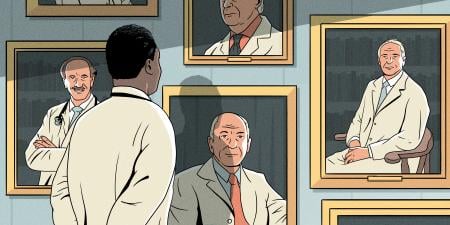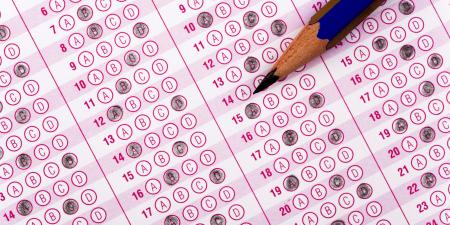Abstract
Individuals living with disabilities are underrepresented in the physician workforce, despite benefits of inclusion. This article describes how both ableism in admissions processes and expectations set by technical standards can perpetuate harm. The authors advocate for active attention to disability diversity and equity in medical school admissions.
Disability Is Part of Diversity
Building a diverse physician workforce that reflects the demographic characteristics of the US population can improve access to quality care.1 As noted by former American Medical Association president, Barbara McAneny: “One requirement to advance health equity is to promote greater diversity among medical school applicants and enrollees.”2
Approximately 61 million Americans (1 of 4 adults)3 and 1 billion individuals worldwide have disabilities,4 composing what the United Nations describes as the “world’s largest minority.”4 Yet, notably, patients with disabilities receive substandard health care and unequal access to health care services.5 This inequity has prompted efforts to improve the quality of disability training in medical education, including initiatives that highlight ways in which socioenvironmental factors shape the disability experience.6,7,8 Greater representation of clinicians with disabilities in the physician workforce could amplify these efforts by dispelling the ableism9—the disability-based stigma that results in discriminatory attitudes and behaviors—entrenched in the medical profession. The infusion of the disability perspective could also foster the humility and shared experience necessary to merge the disability studies and medical approaches to disability,10 in turn bolstering a more enlightened overall approach to respectful inclusion in medicine of both clinicians and patients with disabilities.
Despite potential benefits of increasing representation of people with disabilities in the physician workforce, however, students with disabilities remain underrepresented in US medical schools. In 2019, only 4.6% of students in US allopathic medical schools reported disabilities.11 Students with disabilities (including physical or sensory disabilities, chronic illness, mental illness, and others) encounter multiple barriers to pursuing medical education—from the admissions process through enrollment and application to residency. Barriers include erroneous assumptions about their ability to serve as physicians, challenges navigating disclosure, and inadequate accommodations.12 Barriers can also differ depending on a student’s specific type of disability (eg, students with certain neurodiverse identities may experience profoundly different barriers and degrees of stigma than students with physical disabilities).
Ethical Benefits
Increasing the number of medical students with disabilities, who in turn would contribute to a more representative physician workforce, can help the medical community align its actions with its ethical imperatives of beneficence, nonmaleficence, and justice. Patient-physician racial concordance leads to greater patient satisfaction and use of health care by patients from racial minority backgrounds.13,14 Concordance in disability status might similarly foster greater use of health care and satisfaction in the patient-physician relationship, especially as it relates to clinician understanding of patient needs for accessible care. Patient-physician disability concordance could also reduce discriminatory assumptions about patients’ lives and needs and lead to reduced disparities and better health outcomes,15 at once promoting both beneficence and nonmaleficence. Moreover, in accordance with the principle of justice, patients should have fair access to clinicians who share aspects of their identity, including disability status. Physicians with disabilities, as stakeholders within the profession, can also foster increased justice for patients with disabilities by using their uniquely informed perspective to attune colleagues to considerations related to decision making, resource allocation, applicable laws, access, and inclusion. Importantly, attention to these factors can improve quality of care for all patients and workplace quality for all clinicians, not just patients and clinicians with disabilities.
Given the benefits at all levels of the health care system of including disability in diversity efforts—and given that admission to medical school is the gateway for clinicians to enter the profession—we focus next on barriers to an accessible, equitable admissions process for applicants with disabilities. We share observations from current medical students and provide recommendations for enhancing diversity in medical school admissions.
Students’ Experience of Admissions Processes
During informal conversations, students who identify as having disabilities permitted the first coauthor (N.D.A.) to quote them in what follows. Students shared their experiences applying to medical schools across the United States; their examples evidence alarming ableist tendencies in admissions processes and raise concerns that applicants with disabilities are being disproportionately turned away. The students also offered recommendations about how schools can respond to ableism and foster more equitable admissions processes. Currently, there is no uniform interviewer training on how to approach disability during admissions interviews. A recent study showed implicit racial bias in admissions16; our students’ experiences suggest the existence of disability bias, too, which is manifest in inaccurate assumptions about disability and implicit, inequitable demands that interviewees disclose personal health information.
One student with a disability described a conversation with an admissions officer: “He highly recommended that if I receive any interview invitations, if at all possible, I should wear the prosthesis rather than come in the wheelchair.” In this student’s experience, several admissions officers seemed to have reservations about students with disabilities pursuing medical training: “It [a disability] was a huge deal to them and a complete non-issue to me.” While students with non-visible disabilities could choose to “pass” or hide their conditions, students with non-visible disabilities also shared concerns about bias, as well as challenges with disclosure. Another student related: “I went to great lengths to hide my disability.... I was certain that if my mental illness were disclosed it would affect my admissions prospects.” Concerns about disclosure and subsequent misperceptions make it challenging to describe living with disability in the application essay—even if the experience itself may have sparked an interest in medicine. The same student noted: “I also shied away from meaningful topics on my admissions essays that would have better represented my identity and values.”
Physicians with disabilities, as stakeholders within the profession, can also foster increased justice for patients with disabilities.
Risks of disclosure make it difficult to discuss important topics, such as accommodations, to which a student might be legally entitled. As noted by one interviewee: “I had to choose a med[ical] school with almost no knowledge of how I would be supported after enrolling.” A student whose personal statement explored how their condition influenced their interest in medicine describes one interview as peppered with pointed, inappropriate clinical questions about their personal health. Specifically, the interviewer inquired about the severity of the student’s condition and whether a colleague was the student’s clinician. Although content included in an applicant’s personal statement is “fair game” for discussion during an interview, it should be acknowledged that interview power dynamics can make difficult for a student to insist that personal health disclosure boundaries are worthy of respect.
Technical Standards
Attitudinal barriers faced by applicants with disabilities can sometimes be masked by schools’ purported compliance with “neutral” technical standards, which outline outdated expectations for abilities and skills required for admission to medical school. Guidelines for technical standards were set forth by the Association of American Medical Colleges (AAMC) in 1979 and were updated in 1993 after passage of the Americans With Disabilities Act.17 These guidelines delineate 5 categories of necessary abilities and skills to be present in admitted medical students: sensory, communication, motor, conceptual/integrative/quantitative, and behavioral/social.17 While these guidelines were developed with the aim of protecting service user safety, they were vague, did not offer evidential support, and were not completely prescriptive, which led to heterogeneity among the technical standards developed and followed by individual medical schools.18,19 Anecdotally, from our collective experience, the resultant variability in language, concepts, and presentation in online admissions materials has also led to confusion and frustration among applicants with disabilities.
Technical standards can also be unnecessarily exclusionary toward applicants with disabilities. In its 1979 report, the AAMC described a need to ensure that the medical degree remained a “broad, undifferentiated degree attesting to the acquisition of general knowledge in all fields of medicine and the basic skills requisite for the practice of medicine.”20 This desire to produce the “undifferentiated” graduate discriminates against applicants with disabilities. For example, in McCulley v University of Kansas School of Medicine, a medical student was denied admission because of her inability to meet the program’s motor technical standard of performing cardiopulmonary resuscitation (CPR) chest compressions without accommodations.21 There are a number of medical specialties in which CPR is not a principal duty, and reasonable accommodations, such as an assistant for physical maneuvers, would allow for adequate care. The undifferentiated nature of the medical degree positively ensures that medical students receive access to a breadth of knowledge pertaining to the medical field. In practice, however, applicants with disabilities who are able to pursue some medical specialties face unfair discrimination.
Recommendations
Students who shared the experiences just described also offered recommendations, for example, to “advertise disability and mental health programs” in admissions materials distributed on interview day. One student stated that it would help students answer pressing questions about reasonable accommodations to “offer students the option of speaking with a representative of the disability and inclusion office, but don’t directly ask about student disability.” We recommend that well- and uniformly trained disability officers be made available to respond to applicants’ questions about accommodations before interviews and to act as a resource for admissions committee members’ questions about disability and accommodations.
To further improve equity in admissions for applicants with disability, institutions should uniformly require training for admissions officers that explicitly acknowledges biases associated with disability and how to address them. For example, even starting with an Implicit Association Test could heighten awareness of the biases that can affect admissions decisions.16 Institutions should articulate the value of enriching every medical student class with students with disabilities. Moreover, to demonstrate a commitment to embracing students from the widest possible range of backgrounds, experiences, and perspectives, schools should consider revising technical standards to allow for more inclusive language while continuing to ensure the medical profession’s duties of probity and patient safety. For example, changing “ability to perform CPR” to “ability to direct or perform CPR” could reduce discrimination toward applicants with disabilities.22
There is an ethically urgent need to increase the number of medical students with disabilities, both to provide fair access to an underrepresented minority and, ultimately, to improve care for patients with disabilities. The barriers described in this article suggest specific ways to facilitate greater representation of clinicians with disabilities in the physician workforce. Explicitly including disability as a valued part of diversity would help dispel ableism, limit inaccurate assumptions, and better promote beneficence, nonmaleficence, and justice in health care.
References
- Yancy CW, Bauchner H. Diversity in medical schools—need for a new bold approach. JAMA. 2021;325(1):31-32.
-
McAneny BL. Why the AMA is committed to a diverse physician workforce. American Medical Association. April 23, 2019. Accessed January 15, 2021. https://www.ama-assn.org/about/leadership/why-ama-committed-diverse-physician-workforce#
- Okoro CA, Hollis ND, Cyrus AC, Griffin-Blake S. Prevalence of disabilities and health care access by disability status and type among adults—United States, 2016. MMWR Morb Mortal Wkly Rep. 2018;67(32):882-887.
-
International Day of Persons With Disability, 3 December. United Nations. Accessed January 15, 2021. https://www.un.org/en/observances/day-of-persons-with-disabilities/background
-
World Health Organization; World Bank. World Report on Disability. World Health Organization; 2011. Accessed October 9, 2021. https://apps.who.int/iris/rest/bitstreams/53067/retrieve
- Couser GT. What disability studies has to offer medical education. J Med Humanit. 2011;32(1):21-30.
- Campbell FK. Medical education and disability studies. J Med Humanit. 2009;30(4):221-235.
- Cuff S, McGoldrick K, Patterson S, Peterson E. The intersection of disability studies and health science. Transform J Incl Sch Pedagogy. 2016;25(2):37-50.
- Jain NR. Political disclosure: resisting ableism in medical education. Disabil Soc. 2020;35(3):389-412.
-
Evans JC. Why the medical model needs disability studies (and vice versa): a perspective from rehabilitation psychology. Disabil Stud Q. 2004;24(4).
- Meeks LM, Case B, Herzer K, Plegue M, Swenor BK. Change in prevalence of disabilities and accommodation practices among US medical schools, 2016 vs 2019. JAMA. 2019;322(20):2022-2024.
-
Meeks LM, Jain NR. Accessibility, Inclusion, and Action in Medical Education: Lived Experiences of Learners and Physicians With Disabilities. Association of American Medical Colleges; March 2018. Accessed October 9, 2021. https://sds.ucsf.edu/sites/g/files/tkssra2986/f/aamc-ucsf-disability-special-report-accessible.pdf
- Saha S, Komaromy M, Koepsell TD, Bindman AB. Patient-physician racial concordance and the perceived quality and use of health care. Arch Intern Med. 1999;159(9):997-1004.
- Cooper LA, Roter DL, Johnson RL, Ford DE, Steinwachs DM, Powe NR. Patient-centered communication, ratings of care, and concordance of patient and physician race. Ann Intern Med. 2003;139(11):907-915.
- Iezzoni LI. Why increasing numbers of physicians with disability could improve care for patients with disability. AMA J Ethics. 2016;18(10):1041-1049.
- Capers Q IV, Clinchot D, McDougle L, Greenwald AG. Implicit racial bias in medical school admissions. Acad Med. 2017;92(3):365-369.
-
Association of American Medical Colleges. Americans with Disabilities Act (ADA) and the disabled student in medical school: guidelines for medical schools. June 1993. Accessed June 23, 2021. https://files.eric.ed.gov/fulltext/ED370491.pdf
- Zazove P, Case B, Moreland C, et al. US medical schools’ compliance with the Americans with Disabilities Act: findings from a national study. Acad Med. 2016;91(7):979-986.
- McKee M, Case B, Fausone M, Zazove P, Ouellette A, Fetters MD. Medical schools’ willingness to accommodate medical students with sensory and physical disabilities: ethical foundations of a functional challenge to “organic” technical standards. AMA J Ethics. 2016;18(10):993-1002.
-
Association of American Medical Colleges. Report of the AAMC Special Advisory Panel on Technical Standards for Medical School Admission. Association of American Medical Colleges; 1979.
-
McCulley v University of Kansas School of Medicine, 591 F appendix 648 (10th Cir 2014).
- Meeks LM, Herzer K, Jain NR. Removing barriers and facilitating access: increasing the number of physicians with disabilities. Acad Med. 2018;93(4):540-543.



